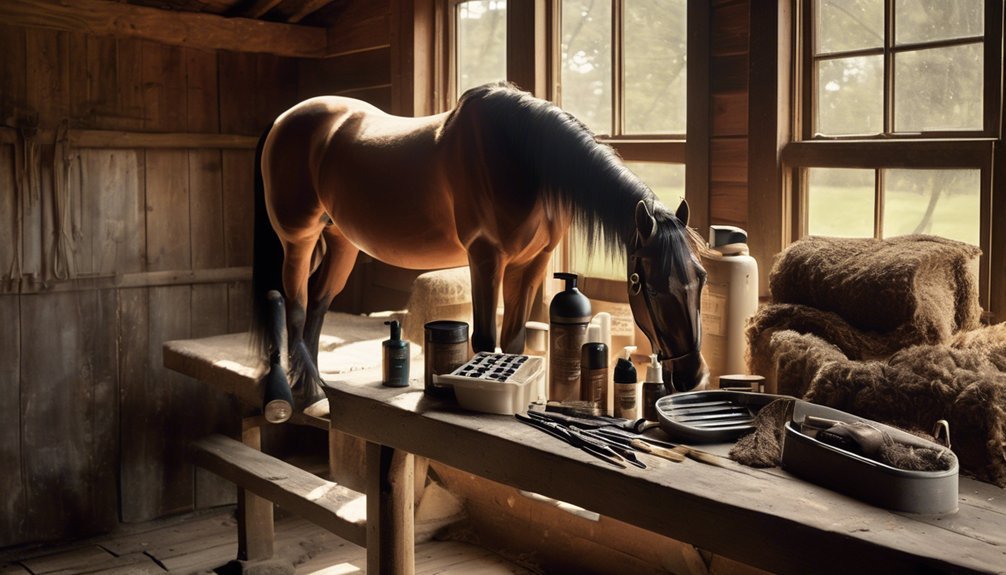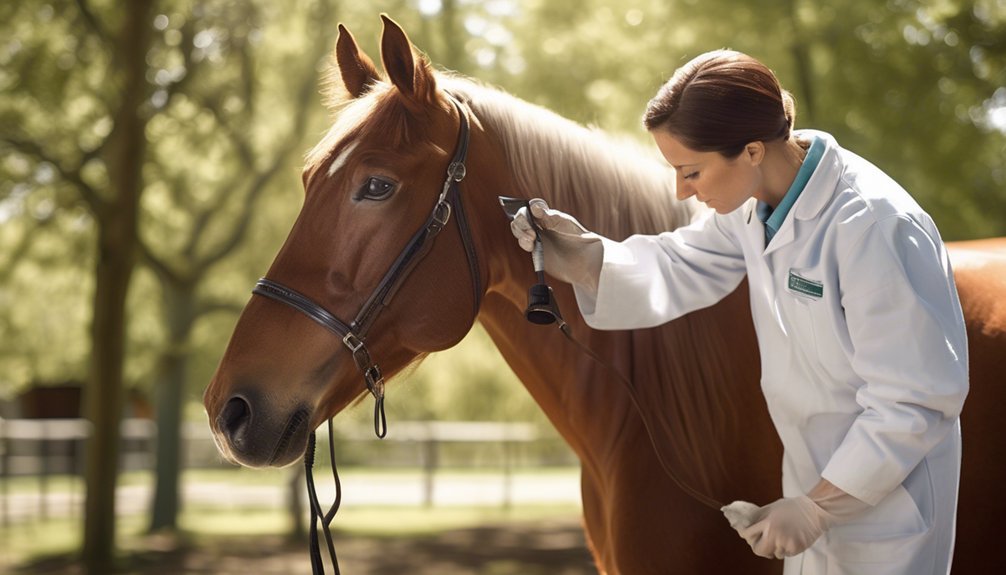
If your horse is prone to skin infections, adopting a tailored grooming routine is crucial. You'll need to understand their unique sensitivities and how proper grooming can mitigate risks. Selecting the right tools and techniques plays a vital role in maintaining skin health. By addressing these aspects, you can significantly reduce the likelihood of infections. However, there are additional factors to consider that could further enhance your horse's skin care regimen.
Key Takeaways
- Regularly inspect your horse's skin for signs of redness, swelling, or discharge to catch infections early.
- Use hypoallergenic grooming products to minimize allergic reactions and skin irritations.
- Groom with high-quality brushes, using stiff brushes for dirt and soft brushes for sensitive areas.
- Bathe your horse with gentle shampoos every two weeks to maintain skin health without stripping natural oils.
- Consult a veterinarian promptly if you notice any unusual skin conditions to ensure proper treatment and care.
Understanding Skin Sensitivities in Horses

Understanding skin sensitivities in horses is crucial for effective grooming and overall health management. Horses possess various skin types, each reacting differently to environmental factors.
You'll want to pay close attention to your horse's individual sensitivities, as certain allergy triggers, such as dust, pollen, or specific grooming products, can significantly affect their skin condition. Recognizing these sensitivities allows you to tailor your grooming routine to minimize discomfort and prevent irritations.
Regularly inspect your horse's skin for signs of inflammation or rash, and adjust your approach accordingly. Choosing hypoallergenic products can also help reduce exposure to common allergens.
Importance of Regular Grooming
Regular grooming is essential not only for maintaining your horse's appearance but also for promoting their overall health and well-being. Consistent grooming frequency helps you identify any skin issues early, preventing potential infections.
By brushing your horse regularly, you stimulate blood circulation and enhance coat condition, contributing to a shiny and healthy appearance. It also helps remove dirt, debris, and loose hair, minimizing the risk of skin irritations.
Additionally, grooming serves as a bonding experience, allowing you to connect more intimately with your horse. Pay attention to specific areas prone to skin infections, as regular grooming ensures you can monitor these regions closely.
Choosing the Right Grooming Tools

Selecting the right grooming tools is key to effective horse care. Start by investing in high-quality grooming brushes tailored to your horse's coat type; for instance, stiff brushes are ideal for removing dirt, while softer ones are perfect for sensitive areas.
Don't overlook hoof care—proper tools like hoof picks and currying tools prevent infections and promote healthy hooves. Each tool serves a purpose, so ensure you have a complete set, including mane combs and sweat scrapers.
Regularly inspect your grooming tools for wear and cleanliness, as dirty or damaged tools can exacerbate skin issues. By choosing appropriate grooming tools, you'll enhance your horse's comfort and health, fostering a deeper bond that thrives on mutual trust and care.
Bathing Techniques for Sensitive Skin
When bathing a horse with sensitive skin, it's crucial to use gentle techniques that minimize irritation. Start by using lukewarm water to avoid shocking their system.
Choose sensitive shampoos specifically formulated for delicate skin, ensuring they're free from harsh chemicals. Apply the shampoo lightly, using your hands or a soft sponge to work it into a lather, but avoid vigorous scrubbing.
Rinse thoroughly to remove all residue, as leftover shampoo can exacerbate skin issues. Limit bathing frequency to once every two weeks to prevent stripping natural oils, unless absolutely necessary.
After bathing, dry your horse gently with a soft towel to avoid chilling. Following these techniques will help maintain your horse's skin health while ensuring a soothing bathing experience.
Maintaining a Clean Living Environment

A horse's skin health is closely linked to its living environment. To promote optimal skin condition, you must ensure that your horse's stable is clean and well-maintained.
Regularly remove manure and soiled bedding materials to minimize the risk of irritation and infection. Use absorbent, dust-free bedding to provide a comfortable resting area while reducing allergens.
Additionally, stable ventilation plays a crucial role in preventing moisture buildup and maintaining air quality. Ensure that your stable has adequate airflow to help dissipate humidity and airborne pathogens.
Regularly check for any signs of mold or dampness in the bedding and stable structure. By prioritizing cleanliness and ventilation, you create a healthier environment, supporting your horse's overall skin health.
Recognizing Signs of Skin Infections
Identifying skin infections in horses is crucial for maintaining their overall health and well-being. You should regularly check your horse's skin for signs such as redness, swelling, or discharge.
Pay attention to areas that seem itchy or inflamed; these are often indicators of infection. Scabs, lesions, or hair loss can also signal underlying issues. Early symptom identification is key to effective infection prevention.
If you notice these signs, consult your veterinarian promptly for an accurate diagnosis and treatment plan. Remember, your horse's comfort and health depend on your vigilance.
Regular grooming and monitoring will help you catch problems early, ensuring your horse stays happy and healthy. Prioritize these observations to create a safe and nurturing environment for your equine friend.
Nutrition's Role in Skin Health

While proper grooming is essential, nutrition plays a vital role in maintaining your horse's skin health. A well-balanced diet ensures your horse's skin remains resilient against infections. Essential nutrients, alongside adequate hydration levels, can significantly improve skin condition. Don't overlook dietary supplements like omega-3 fatty acids and biotin, which can enhance skin integrity and coat quality.
| Nutrient | Benefits |
|---|---|
| Omega-3 Fatty Acids | Reduces inflammation |
| Biotin | Supports hoof and skin health |
| Zinc | Promotes healing |
| Vitamin E | Acts as an antioxidant |
| Probiotics | Improves gut health |
Seasonal Grooming Adjustments
As temperatures shift with the changing seasons, adjusting your grooming routine is crucial for maintaining your horse's health and comfort.
Seasonal allergies can exacerbate skin issues, so it's vital to be proactive. You'll notice coat changes that require specific attention.
Consider these adjustments:
- Regular Brushing: Increase brushing frequency to remove loose hair and dander, reducing allergens in their environment.
- Bathing Frequency: Adapt the frequency of baths, using gentle, hypoallergenic shampoos to keep the skin clean without stripping essential oils.
- Moisture Management: In damp seasons, ensure your horse's coat is thoroughly dried to prevent fungal infections.
Consulting a Veterinarian for Skin Issues

When your horse develops persistent skin issues, it's essential to consult a veterinarian promptly.
Veterinary consultations are crucial for diagnosing underlying conditions that may not be apparent during your routine care. Your vet will perform comprehensive skin assessments, examining lesions, irritations, or any unusual signs. They can identify infections, allergies, or parasites that require targeted treatments.
By sharing your observations and concerns, you empower your veterinarian to provide tailored solutions for your horse's needs. Early intervention can often prevent more severe complications, ensuring your horse remains comfortable and healthy.
Don't hesitate to reach out; your horse's well-being depends on your proactive approach to managing skin issues. Trusting your veterinarian will lead to a better quality of life for your equine companion.
Frequently Asked Questions
How Often Should I Groom My Horse to Prevent Skin Infections?
You should groom your horse daily to maintain a healthy coat and prevent skin infections. Establishing consistent grooming routines not only removes dirt but also promotes bonding, ensuring your horse stays clean and comfortable.
Can Certain Grooming Tools Cause Skin Irritation?
Did you know that nearly 30% of horses show skin sensitivity? Certain grooming tool materials can exacerbate this. Conduct a skin sensitivity assessment before use to avoid irritation and ensure your horse's comfort during grooming sessions.
What Are the Best Products for Sensitive Horse Skin?
For sensitive skin, choose hypoallergenic shampoos and conditioners to promote allergy prevention. Look for products with soothing ingredients like aloe vera or oatmeal. Regularly check for irritants, ensuring your horse stays comfortable and healthy.
How Do I Safely Introduce New Grooming Tools to My Horse?
To safely introduce new grooming tool types, start slowly, observing your horse's sensitivity. Use soft brushes first, allowing them to acclimate. Always reward positive reactions, creating a trusting environment for future grooming sessions with new tools.
Are There Specific Breeds More Prone to Skin Infections?
Certain skin infection breeds, like thoroughbreds and warmbloods, show higher breed susceptibility to skin issues. Understanding these tendencies helps you manage their care better, preventing infections through vigilant grooming and attention to their unique needs.
Conclusion
In conclusion, adopting a diligent grooming routine for your horse can be the difference between a shiny coat and a battlefield of skin infections. By selecting the right tools, practicing careful bathing, and maintaining a clean environment, you can keep your horse's skin healthy and resilient. Always stay vigilant for any signs of irritation, and remember that a well-groomed horse is not just a sight to behold but a thriving companion ready for any adventure.





